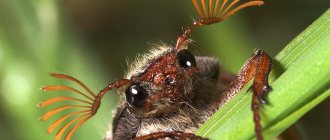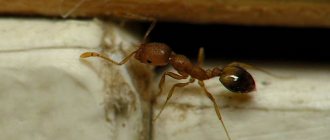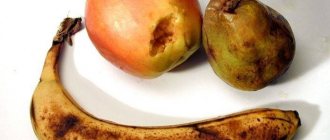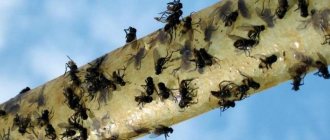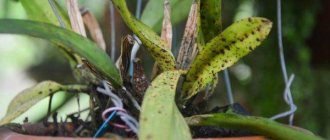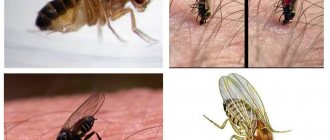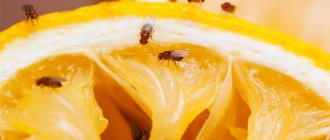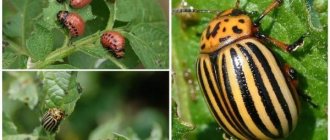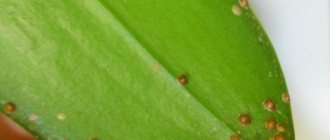Description of appearance
The body structure of the green carrion fly is similar to that of a regular fly, only the first one is slightly larger. The length of its body reaches 1.5 cm. The eyes look like large red spots that occupy a large area of the head. The back and abdomen have an emerald shine with golden tints. In the photo of a green fly you can clearly see its bright color.
On a note!
The scavenger moves much slower than its relatives. It is easier to catch or kill it mechanically. Another difference between an insect and an ordinary fly is a significant hum during the flight, so you can immediately understand that a green carrion fly has flown into the house.
Types of flies, names and photographs.
There are 3,650 species of flies in the world, some of which are particularly common:
The housefly is a gray insect native to the Asian steppes. Distributed everywhere, most often near human habitation. Externally, many species are similar to the house fly, but it is distinguished by a special break at the edge of the wings. Under favorable conditions, the insect can live up to 2 months;
hoverfly (syrphid) - similar in appearance and habits to. The insect is distinguished by a black and yellow striped body and transparent wings. The hoverfly feeds on the nectar of flowering plants and is absolutely harmless. The fly got its name from the murmuring sound made by its wings when hovering;
green (carrion) fly. An insect with a shiny emerald body that lives near sewage and carrion. To avoid being eaten after mating, the male fly first offers the female some food;
The common milkweed (tenacious) or bee-fly is considered a subspecies of hoverflies. A large insect, up to 1.5 cm long, with a dark-colored body covered with hairy pubescence. Beeworm larvae that enter the human body can cause serious intestinal disorders;
Ktyr is a large predatory fly that poses a danger to midges, as well as similar flies. Killing various dangerous insects with a sharp sting and poison, tyri flies bring significant benefits to humanity;
The Tsetse fly is an inhabitant of the African continent. The main source of nutrition for this dangerous predator is the blood of wild mammals, as well as livestock and people. Tsetse flies are carriers of trypanosomes, which cause an incurable disease that destroys the immune and nervous systems and leads to death.
Tsetse fly. Alan R Walker, CC BY-SA 3.0
A brief excursion into biology
Carrion flies are insects with a green body (with a metallic or golden tint). The size of carrions is up to 1 cm. The antennae are strewn with bristles. They are found everywhere, both on the street and in houses. Green flies carry microbes and parasite eggs.
There are more than 1,500 species comprising various carrion or blowflies. All of them have a brightly colored body, with a metallic tint, green or blue. Green blowflies belong to the genus Lucilia.
For nutrition, they use liquefied material of rotting organic matter (pus, decomposing proteins), which are liquefied under the influence of enzymes secreted by the maggots themselves.
Biology
Adults of calliphorid flies are, as a rule, brightly colored green or blue with a metallic tint; less often dark gray with brown.
Typically carrion flies that develop on corpses are representatives of the main genera of the family - green carrion flies (Lucilia) and blue carrion flies (Cynomya, Calliphora). Their females require a significant amount of protein (up to 800 mcg) to develop eggs. Having found carrion (sometimes the fly has to fly up to 20 km to do this), females lay white eggs measuring 1.5x0.4 mm - 150-200 eggs at a time. In total, a female can lay up to 2000 eggs in her life. For the larvae to hatch, it takes from 12 hours to 1-2 days (depending on the ambient temperature). Digestion in larvae is extraintestinal - they absorb food liquefied by their proteolytic enzymes.
There are two types of carrion fly larvae: smooth and “hairy”. The first are exclusively scavengers; the latter are predominantly active predators, feeding on smooth larvae, and appear on carrion later than the former.
The larvae go through three moults and then pupate. At room temperature (approx. 30 °C), the black carrion fly Phormia regina transforms from egg to pupa in 6-11 days. The larva burrows into the ground and, if the weather is favorable, emerges from the puparium after 14 days as an adult insect. Because the life cycle of carrion flies is well understood, they are used in forensic science to determine the time of death.
In addition to carrion, many species of carrion flies develop on the excrement of humans and animals. It is not uncommon for the same species to develop both on carrion and in feces. Feeding on decaying meat has created the preconditions for a number of species of carrion flies to transition to parasitism on living beings: pollen flies (Pollenia), for example, retain the ability to develop in meat, but their larvae are often found in the body of earthworms, which they gradually eat. There are species that parasitize snails and live in termite mounds and anthills. Parasitic carrion flies can develop in necrotic tissues and cause myiases in animals and humans. Thus, the damage caused to the Australian sheep industry by the fly Lucilia cuprina, which parasitizes sheep, is estimated at 170 million US dollars annually.
Adult carrion flies sometimes become pollinators of flowers, to which they are attracted by a strong smell, similar to the smell of rotting meat (like pawpaw).
Life cycle of green mosquitoes
Bells are insects with a full cycle of transformation. The fertilized female lays eggs on the water surface or leaves of plants growing near the water. After a few days they sink to the bottom or fall into moist soil.
Bell bell larvae are gray in color. After hatching from the eggs, they burrow into the mud and spend two to seven weeks there. During this period, future insects feed on soil particles and remnants of organic compounds found in the ground or at the bottom of the reservoir. During this time, the color of the larvae changes and by the time of pupation they become bright red.
Green mosquito pupae have tracheal gills. After they rise to the surface, the cocoon with the formed imago bursts under the pressure of the air collected inside the capsule.
The appearance and color of the adult depends on the insect's habitat. Female bells die immediately after laying eggs. Males live a little longer, but since they are deprived of the opportunity to consume any food, the average life cycle of adult insects does not exceed one week.
External body structure
The general body plan of the fly is the same as that of other winged pests. The head contains the mouthparts, organs of vision and antennae. On the chest are transparent wings and three pairs of legs. The abdomen hides the digestive and reproductive systems.
Important: insects have pronounced sexual dimorphism, that is, females are visually different from males.
Head
The main feature of the fly is its compound eyes. They allow you to view the space 360 degrees. There are more than 3,000 small facets in each eye. Each eye transmits a separate image to the brain, where the overall picture is formed.
The fly obtains food for itself with the help of its proboscis. It can be of two types:
- Sucking.
- Licking.
In an insect that feeds on blood, the mouthparts are additionally equipped with sharp plates that help pierce the skin of the prey.
With the help of antennae placed on the head, the pest orients itself in space. The front sight determines the direction of movement and also picks up odors.
Important: males have large eyes, thanks to which they react faster.
Chest and wings
The fly's chest is divided into three segments. The most developed is average. This is due to the fact that the insect flies a lot. There are 6 paws on the chest, with the help of which the pest can crawl not only on a horizontal surface, but also on a vertical one. Each paw is equipped with suction claws.
Important: with the help of the fly's legs it determines the taste of food.
Few people know, but the pest has 2 pairs of wings. Some are large, others are small - halteres. They are the ones that make the annoying sound.
Abdomen
The third part of the body is the abdomen. It has a cylindrical shape and consists of 10 segments. The abdomen contains organs responsible for respiratory function, nutrition and reproduction.
Flies that live in apartments weigh about 13 mg. The abdomen can accommodate 3 mg of food, that is, body weight after “breakfast” increases to 16 mg.
Types of midges and reasons for their appearance
Many housewives wonder where midges come from in their apartments. Most often, insects appear in summer or autumn, but they can also appear in winter, even in a room with tightly closed windows and doors. Therefore, before you start fighting them, you need to find the source of their occurrence:
- Contaminated and slightly rotten fruits brought into the house from a store or garden are the most common cause of midges appearing in the kitchen. They create ideal conditions for insects to feed and reproduce. Midges are especially common on the balcony in the fall, where a lot of vegetables are stored for canning. To get rid of it, you need to destroy the missing products.
- Poor trash bin hygiene and irregular waste disposal may also be a precursor to the appearance of fruit flies in the kitchen. Despite the fact that the lifespan of insects is only a day, they manage to lay eggs in rotting food waste. As a result, you have to look for ways to get rid of midges in your apartment.
- Failure to clean your pet's cage in a timely manner can also cause midges to appear in your apartment. An unkempt dog or cat bowl, a dirty aquarium and rotting algae in it are excellent sources for the spread of insects. Regular cleaning of your pet's dishes will help get rid of pests in your home.
- Midges in the house can start in the soil of indoor plants. Excessively abundant watering and fertilization with used tea leaves create favorable conditions for the proliferation of flower midges on windows.
- The cause of midges in the kitchen may be a clogged drain. Food particles stuck in the siphon continue to decompose there, which provokes the emergence of new individuals. In such a situation, cleaning the siphon with a special product will help get rid of insects.
- Faulty plumbing can also contribute to the presence of midges in the kitchen. A constant leaking faucet creates dampness in the apartment, which insects love so much.
- Insects can enter the kitchen through the vents or simply fly into the house from the street through a window or door.
Midges are two-winged insects that are similar to flies, only smaller in size. There are three types of pests most commonly found in kitchens. Here it’s worth mentioning right away where they come from in the apartment, because they penetrate your life in completely different ways.
- Drosophila - they are also called fruit and wine midges. They are easily recognized by their dark yellow, orange, brown or black color. They love rotten remains of fruits and vegetables, waste from the trash can and sweets. They are able to take a liking to wet rags that have been lying around for a long time. You bring them from the market or from the grocery store.
- Sewer flies are black in color, their bodies are densely covered with hairs. They live in sewers and other damp and warm places. They appear if food waste has accumulated in the drain.
- Sciarides are fungus gnats. In appearance, they really look like small mosquitoes from light gray to black. They attack indoor plants and love waterlogged soil. They end up in a home with poorly cultivated soil, or they can fly through an open window and find refuge in an indoor flower.
If we talk about sewer flies, they are carriers of dangerous microorganisms, and fruit flies accelerate the process of spoilage of good vegetables and fruits by spreading rot particles from spoiled ones onto them. Sciarid larvae feed on root sap and impair oxygen exchange in the soil, so don’t be surprised that plants wither.
In general, it’s not very pleasant. Add to this the even more disgusting sight of hordes of small insects circling around your home, and the danger of them getting into your nose, eyes and ears. It becomes absolutely clear that unpleasant guests need to be dealt with quickly.
Appearance Features
Externally, the green carrion fly differs from the house fly in its larger body size, bright green color with iridescence, and a metallic tint. The external and internal structure of the body is ideally suited to her lifestyle.
- Size from 8 mm to 2 cm.
- The entire body is densely covered with short villi.
- There are small antennae on the head.
- The head is well defined with large red and brown eyes.
- A pair of transparent wings with well-marked membranes. Located along the body, slightly splayed to the sides.
- The second pair of wings are underdeveloped and are called halteres. They perform an important function - they maintain balance in the air, allow you to hover in one place, and also create sound during flight.
- 6 pairs of paws. A special fatty substance collects at the tips, which allows flies to easily stay on any surface in a vertical or horizontal position. This explains how the insect sits calmly, crawls on the ceiling and on the glass of the windows.
A photo of a green fly is shown below. The insect lives in the wild and enters the house by accident or under certain circumstances.
Interesting!
To search for food, a fly can fly up to 20 km, and can fly almost 3 km without stopping. Orients with a sensitive sense of smell and excellent vision.
The three most effective ways to deal with annoying midges
1 way. Industrial insecticides
In the event that general cleaning does not give the expected result, and harmful flies continue to scurry around the apartment, you, of course, can poison them with some kind of insecticidal aerosol, but the same dichlorvos, for example, is allowed to be used only in the toilet and living rooms, It is unacceptable to use such a toxic pesticide in the kitchen.
In areas where food is stored or prepared, it is better to use factory-made adhesive tapes to combat midges. Unfold and hang a couple of Velcro strips under the kitchen ceiling, and the very next day you will see that the number of small “saboteurs” secretly sneaking into your home has decreased significantly.
A fumigator can also be an excellent way to solve the problem of fly infestation. Fill this device with a special plate that acts on flies, or attach a reservoir with anti-fly liquid to it, turn on the unit all night, and in the morning you will not find a single fruit fly in your house.
Method 2. Homemade traps
Fruit flyers can be fought not only with chemicals, but also with safer, but no less effective folk remedies, which include the homemade traps described below.
Drunken trap. Flies love beer and dessert wine. Place an open, unwashed beer or liquor bottle on the kitchen counter. After a couple of hours, a large number of fruit flies will gather in it, flocking to an unexpected feast, all you have to do is plug the cap of the vessel full of midges and take it to the trash heap.
Apple trap. No less than sweet alcoholic drinks, fruit flies love apples. Taking advantage of this weakness, you can build a very effective trap, in which natural apple cider vinegar will play the role of bait. To make such a trap, take a half-liter jar, fill it a quarter full with warm water, pour a spoonful of natural apple cider vinegar into the water, the smell of which has a mesmerizing effect on midges, and add a couple of drops of shampoo or dishwashing liquid. Attracted by the aroma of your favorite fruit, the midge will fall into the water, and the “sticky” soap film formed on the surface of the liquid will not allow it to fly back up.
3 way. Repellents
If you don't have time to build traps, try scaring away unwanted guests with some kind of unpleasant smell. As such “horror stories” you can use:
- camphor, the smell of which all flies and mosquitoes really dislike. Throw a pinch of this substance into a heated dry frying pan and, as soon as its crystals begin to emit a characteristic wormwood aroma, immediately remove the vessel from the stove and walk with it throughout the apartment. Having smelled the smell of camphor, the flies will be forced to retreat.
- garlic - garden midges are afraid of the smell of this plant, so they can repel flies that have chosen flowerpots with indoor plants. Cut a few cloves of garlic into slices, place them on the surface of the substrate in flower pots, and the midges will soon leave their homes.
- cloves, the rich aroma of which plunges midges into panic. Place a dessert spoon of clove buds in a small ladle, fill them with a glass of water, and place an impromptu aroma lamp on the stove. When the liquid in the ladle begins to boil, a thick spicy spirit will spread throughout the apartment, which will disperse the “stray” guests.
Who among us has not encountered this problem? Midges appear suddenly in an apartment and are very annoying, annoying the residents with their presence. Some species - and there are a lot of them - can even bite. But the good news is that the methods of dealing with them are the same, and you don’t have to read a bunch of literature in order to determine which of their representatives you are fighting with.
Habitat
Emerald lucilia is common in many countries of the world with warm summer climates. Its peak activity occurs during the hottest time of the year. It is in the heat that decay processes most strongly emit an odor, which is a bait for insects. In addition to carrion, green-bellied flies are also attracted to other sources of unpleasant stench:
- feces;
- rotting fruits and berries;
- plants with a rotting smell;
- food waste landfills;
- fresh and salted fish;
- meat.
Large concentrations of carrion insects can be seen near slaughterhouses, meat shops, and livestock farms. They are also found in large numbers near fish processing plants, where fish are cleaned and cut.
On a note!
An apartment or house can attract meat midges if there is rotting waste or a dead animal somewhere nearby. Otherwise, the fly can only fly in by accident and will try to fly out at the first opportunity.
Nutrition
For food, flies and larvae use the meat of decomposing corpses, rotting fruits and vegetables, meat products, as well as other organic substances that are in the process of decomposition.
Among other things, the blowfly larva can eat the eggs of beetles, other flies, grasshoppers and caterpillars. They are characterized by extraintestinal digestion of food.
Habitat
When the fly is not looking for food or a place to lay larvae, it can be found on various flowers, near cesspools and latrines.
As for the larvae, they can be found not only on rotting fruits and decomposing corpses, but also on feces, manure, in a polluted body of water, and even in an open wound of an animal.
Name, description, habitat
The name "carrion flies" ( blow flies)
), probably goes back to Homer's Iliad, which describes the lightning-fast reaction of flies that attacked the bodies of soldiers killed on the battlefield. The author of the poem talked about it this way: “I will try to drive away the ferocious flocks of flies // Eating the corpses of men killed in battles.” It also spoke about the ability of flies to quickly fill wounds with larvae: “As if in the meantime the flies, having penetrated deep wounds, // Punched with copper in the body of Menetyev’s powerful son, // Didn’t give birth to worms. They mutilate the body: // The life is torn out of it! And it will begin to decompose." The so-called specialized carrion flies also include green flies, the adults of which accelerate the decomposition of dead bodies.
Green carrion flies are flies with a shiny metallic abdomen of green or golden-green color. Their length varies from 6 to 10 mm. The antennae have feathery bristles. Distributed everywhere, including in homes and gardens. The most natural habitat for them is places where food is sold openly, slaughterhouses, garbage and cesspools. Often found in large numbers on excrement, carrion or rotting meat. They are carriers of microbes [ specify
] and eggs of parasitic worms. They feed on liquefied, decaying material.
Types of blow flies
The most common types of blowflies include the following:
- green;
- gray;
- blue.
Green fly
The green blowfly has a body size of 5...10 mm in length, which has a greenish color that shimmers with a metallic tint. The insect's abdomen has a somewhat lightish tint.
Green fly
The fly's legs are black, the tentacles are slightly yellowish, and the wings are transparent. This type of fly is very thermophilic and is mainly found in hot summers.
gray fly
Gray blowflies have a fairly large body, the length of which can range from 10 to 15 mm. Attached to the body is a white and yellow head, divided by a black stripe and having red eyes.
gray fly
The insect's chest is covered with light stripes, which are located longitudinally. The legs of the fly are distinguished by thick, short hair.
blue fly
The blue blowfly is one of the largest - its body length can be 10...16 mm, and its color is blue with a lightish tint. Attached to the body is a head, colored yellowish-red with a golden sheen, and having short antennae on the sides.
gray fly
The insect's chest is painted black with an iridescent bluish tint, and black stripes are visible on the back.
Reproduction
The green fly lays about 150 eggs at a time, but in a day their number can reach five hundred. To protect the offspring from bright sunlight, to which they are very sensitive, the female looks for deep folds or holes in the flesh of the carrion, and, if possible, climbs under the corpse to lay eggs.
The insect is not at all concerned about other scavengers, such as ants, which carry freshly laid fly eggs. Her offspring are so numerous that such petty theft will not affect the general population.
Development
During a fairly short life, which is approximately 2 months, the common lacewing makes two clutches, usually not far from the places where aphids live. Each of them can contain from 100 to 900 eggs. They are green at first, but gradually darken.
The eggs are attached to a narrow stalk up to 3 mm long and then become like some kind of mushroom rudiments. To make such a stalk, the lacewing presses the end of the abdomen to the leaf and distributes a thick, rapidly solidifying drop of liquid, which it then pulls out, raising the abdomen in the process.
The next stage is the larva. Develops within 2-3 weeks. When hatching, it immediately molts and begins to feed. It can eat almost a hundred aphids in a day.
During the next moult (after 3-4 days) it turns into a pupa, which after about a week cuts out a certain door near the cell and crawls out. Then it attaches itself to the cocoon and after five minutes a beautiful creature is born, which soon becomes a fleur-bearer.
In warm regions, the common lacewing develops rapidly, and that is why four generations are replaced in one year; in the subtropical zone it reaches eight. But in the north only one offspring appears.
Larvae
The larvae of green flies hatch from eggs a day after laying. They are small in size, whitish with a small black head, which has a mouth opening and two sharp hook-shaped protrusions, which the larva controls: it pulls forward, sticks into rotting flesh, and hides. Some sources suggest that these are modified jaws of the larva, with the help of which it captures microscopic pieces of flesh. Actually this is not true. The larva uses its hooks exclusively as a propulsion system. By thrusting them into the flesh, it tightens the body, so it is able to move.
How do larvae eat?
The larva cannot yet bite off pieces of solid food. How does she eat? During the research, an experiment was carried out: pieces of slightly dried meat were placed in two flasks, and green fly larvae were planted on one of them. After a few days, the piece of meat on which the larvae lived became so soft that it resembled more of a liquid pulp. At the same time, the piece of meat in the second flask did not change at all. That is, the larvae, secreting a special secretion from their mouths, liquefy solid food, turning it into a kind of broth, and then feed on this broth.
It turns out that they digest food before eating it. In addition, the hook-shaped projections on the head of the larva are also involved in the process of such digestion. As the larva digs its hooks into the flesh, it secretes digestive juices. It is absorbed into the meat in the places where the hooks were attached.
Having reached a certain age, the larva burrows into the ground, where it pupates. After a while, the cocoon lid bursts, and a young green fly appears from under the ground. After drying the wings a little in the sun, she rushes off in search of rotting flesh.
Remedy for midges in the apartment
To combat Drosophila, both purchased and homemade products are used.
Midge trap in the kitchen
One of the effective methods of controlling midges is making a trap. It is easy to cope with this task, even without experience. Instructions:
- Find a jar with a wide mouth and a lid.
- Drill holes in the cover.
- Pour apple cider vinegar into a container.
- Close the jar.
Attracted by the aroma of apple cider vinegar, the pests will fly into the jar and drown.
Folk remedies for midges
Sometimes housewives fight midges with an ordinary vacuum cleaner
It is important to dispose of the contents of the bag outside the home.
Another popular remedy is horseradish. The root, cut into slices, is laid out around the room, the window is opened, and after a while the midges leave the room.
You can use verbena, ylang-ylang, clove or patchouli essential oil. A few drops applied to a cotton pad can repel annoying insects. Also, midges do not like the smell of vanilla and mint.
Stages of development
The green fly goes through the following stages in its development:
- Egg – 8-25 hours.
- Larva (maggot) – 10±3 days.
- Pupa 3-4 days.
- Adult – 45 days.
Carrion birds quickly find open wounds, dead birds, animals and lay eggs there on the very first day. But they can also be deposited in the damp soil of flowerpots, on rotten fruits and vegetables. The eggs look like white sticks 1 mm long. Development time depends on temperature and humidity.
After a day, small larvae (a little more than 1 mm) appear from them. They develop on a favorable basis - kitchen waste, feces, animal corpses. They have 1 mouth opening plus 2 respiratory openings. There is a black hook in the mouth with which they move.
The larvae constantly secrete juice through this hook, as if from a syringe, under pressure. Under the influence of fermented juice, the tissues quickly dissolve, forming a corpse broth on which the insect feeds. The larvae grow quickly, become thicker, larger, moving to pupation after 7-14 days, choosing warm, dry places.
The pupal stage (puparia) lasts 3 days. After hatching, the adults are ready to reproduce. Each female is capable of laying 100-150 pieces per day, repeating the process every 2 days. During its short life, 1 individual is capable of reproducing up to 700 eggs (6-8 clutches).
Some types of carrion flies can lay up to 2000 pieces in 1.5 months. During one warm period, several generations appear. In warm, indoor areas, insects can breed year-round. They overwinter in any phase except eggs.
Classification of flies
They still cannot systematize flies, proposing various ways to divide these insects into orders, genera, families, etc. But the ordinary inhabitant of the planet is of little interest in such methods of classification as the shape of the seam along which the pupa bursts, or the length of the whiskers of a fly. But the food habits of flies worry everyone, since the comfort of human existence depends on it. And the division of dipterans according to nutritional factor is quite clear and does not cause confusion.
According to the nature of feeding of adult flies, there are:
- nectarivores;
- aphagi;
- hematophagous;
- coprophages;
- necrophages;
- polyphages.
The second part of these words comes from the Greek phagos - “devouring” and indicates the type of food that each of the groups eats.
The food of nectarophages is the nectar of flowers, aphages do not eat at all as adults, hematophages drink blood, coprophages eat excrement, necrophages eat dead flesh, and polyphages have a very extensive food base. A striking example of a polyphage is the housefly.
Harm and benefits of green flies
The main danger of blowflies is that they spread many diseases on their bodies, including cholera, dysentery, intestinal myiasis and typhoid fever. And given their fantastic reproduction speed, flight speed and penetration into all cracks, such a danger is very likely.
Flies also spoil a huge amount of food products, causing huge losses to food industry enterprises and livestock farming (they lay eggs in the nose, eyes, genitals, wounds, and transfer various pathogens and parasites from sick animals to healthy ones).
There are also benefits from carrion. By knowing the timing of blowfly development at all stages, forensic scientists can determine the time of death to the day, even if the body has been adversely affected. Insects were first used in search of killers back in the 13th century.
During the war, 100 years ago, maggots were used for field cleaning of wounds from dead flesh. Having learned that the juice of the larvae dissolves only areas that die and does not touch the living ones, they began to use them to remove necrotic layers.
First, they filled the wounds with maggots, and after a certain time they removed the cleaners, carefully cleaned the surface of the wound and obtained clean, living and sterile flesh. For medical purposes, special larvae were used, the cleanliness and sterility of which were monitored so as not to further infect the wounded.
Even now, options for using carcasses to treat tissue necrosis are periodically being developed, since dead tissue cannot be removed surgically so thinly, nanometers in size.
How to get rid of house flies in the bathroom?
Also, one of the places where unexpected guests attract is the bathroom. If you do not monitor cleanliness and do not clean regularly, a large swarm of midges may appear. Breeding sites can be:
- Wet rags, napkins, mop.
- Damp dirty laundry.
- High humidity.
- Hood
- Sewer pipes
For prevention, you need to perform simple manipulations:
Monitor air humidity
Be sure to wash and dry all rags and clothes
It is also important to clean the pipes in your sink and bathroom regularly. Many different special products are sold in stores for this procedure.
They are available in both granules and liquid form. Each product comes with its own instructions. Liquid products and gels are poured into pipes, and granules are poured into them. For the granular powder to start working, you need to pour a little boiling water over it. Then the product is left for some time. Afterwards everything is washed off with water. If there is high air humidity in the bathroom, you need to monitor the ventilation system. If there is a hood, it must be cleaned. Also keep the door to the room open more often.
Breeding
For those who are not against breeding blow flies, and in particular their maggot larvae, this section of our story is intended. We will tell you how to make the simplest maggot from our favorite material for all kinds of crafts - an indispensable plastic bottle.
This is done as follows:
- Cut the plastic bottle into two parts so that the upper part with the neck, being turned over and inserted into the lower half, does not reach the bottom by 4-5 centimeters.
- Pour sawdust into the lower part of the “one and a half” or “kopeck piece” in a layer of two to three centimeters.
- Place a piece of fresh or spoiled meat or a piece of fish in the upper part. By the way, you can also add a few small fish that you discarded after fishing.
- Place the maggot in a shaded area.
When the meat begins to spoil, the flies will smell it and lay eggs there. The hatched larvae will feed on the substrate offered to them. Soon, a week after their eggs hatch, they will stop feeding in preparation for pupation, and will leak through the neck of the bottle straight into the sawdust.
Thanks to crawling in sawdust, maggots will be cleared of the smell of carrion, and you can take them with you fishing without hesitation. If you put an egg in a maggot, the larvae will be the largest.
Reasons for the appearance of midges in the house
Until you find out why these small insects appeared in your home, you will not be able to completely remove them.
The appearance of midges is associated with the following factors:
With irregular cleaning of the trash can, delay in taking it out. The temperature and especially humidity in a garbage heap with organic waste is slightly higher than in the environment. The remains of vegetables rot, midges begin to multiply. They notice insects when they are already flying everywhere. Often, midge eggs are laid on the walls and bottom of the bucket, and if it is not washed periodically, the insects will also begin to actively reproduce.
In most cases, insects breed in rotting environments.
With unwashed fruits and vegetables from the garden or store. Many people believe (and not without reason) that the harvest from their own garden is the best, without nitrates, etc. They don’t wash the fruits right away, they begin to spoil. As a result, midges appear. The same thing happens due to lack of time or simply laziness with vegetables and fruits purchased at the nearest market or store.
Dirty or spoiled fruit.
With rotting of the roots of indoor plants. This happens when the latter are watered abundantly. Any soil that is not sterilized contains midge eggs. As soon as a nutrient medium appears, small parasites immediately begin to multiply.
Flower plants. Midges appear in pots due to excess moisture.
With improper fertilization of house plants. Tea is often used for the latter. The midges love him very much.
They parasitize house plants, inhibiting their growth.
With placing indoor plants on the balcony. Insects can come from the street. Therefore, if you have already placed pots of flowers there, check them as often as possible.
The presence of unkempt indoor plants.With irregular cleaning of the tray and the habitat of pets, especially rabbits, hamsters and guinea pigs.
There is always organic matter there; if you don’t clean it out regularly, it rots.
With improper care of the aquarium. Algae can also decompose. In addition, fish require moderately warm water.
These are ideal conditions for the appearance of rot, and therefore midges.
With clogged water supply and sewer systems. First of all, with siphons for sinks and toilets. Residues of food settle at the bottom, and if not cleaned in a timely manner, they rot. The result is not difficult to predict.
Malfunction of the sewer system or other communications, leaking pipes.
Medicine
During the First World War, the unexpected property of carrion fly larvae settling in festering wounds was discovered. It turned out that the larvae of green carrion flies (Lucilia), blue carrion flies (Calliphora), etc., feeding on decaying tissues of wounds, not only remove these tissues and small fragments of bones, but also prevent the proliferation of pathogenic bacteria with their secretions. In addition, they secrete allantoin, a substance that promotes wound healing. However, flies taken from natural environments can introduce anaerobic microflora into wounds. Therefore, for the clinical treatment of difficult-to-heal wounds, laboratory-reared (sterile, that is, free from pathogens) larvae are used.
Functions in nature and harm to humans
For humans, all types of blow flies pose a great danger, namely epidemiological. After all, each of these insects is a potential carrier of various infectious diseases, including parasitic, bacterial and viral diseases. One of the most terrible diseases that a blowfly can carry is leprosy (leprosy), and the most common are various intestinal infections.
The fly gets infected due to the fact that it is constantly in contact with dirty places that are rich in feces, decaying biological tissues, rotting organic matter, etc. After this, the fly may end up on food, through which the infection can reach humans.
Blowfly eggs (larvae) can cause parasitic diseases in both humans and animals.
Blowfly eggs (larvae)
In addition to humans, blowflies are also very dangerous for animals. For example, in countries with warm and humid climates, there are many green blowflies, which cause the death of newly born lambs. Female flies can deposit their larvae in sheep's wool, as well as in open wounds, which will cause them to burrow under the skin of the animal, corroding its tissue.
Blowflies can also cause harm to fisheries or fish products. The female quite often deposits her larvae in fresh or lightly salted fish, which is why it loses its presentation and quickly deteriorates.
In addition to the negative aspects, the blowfly also has a positive property - it is nature’s orderly. Since flies feed on carrion, as a result of their vital activity they destroy rotting flesh and decomposing organic waste, preventing them from polluting the environment.
Prevention and safety measures against flies
The basic rule of hygiene always comes first, which concerns not only hand washing, but also the proper handling of food before eating it.
It is important to keep household items and utensils in proper condition. If food remains on the table in the summer, it must be covered with a special lid, mesh, or placed in an airtight container.
If flies enter the house, it is necessary to carry out special treatment using repellents. If an egg laying site is discovered, it must be thoroughly treated with chlorine-containing agents and chemical aerosols against these insects.
It is necessary to take care of the area where the garbage container is located - this area must be kept clean. Outdoor toilets must be equipped with special outlets for water flushing and basic cleaning of the premises. For barns and other premises intended for keeping livestock, there are special traps for winged pests. These are sticky tapes, hanging feeders with a sticky bottom that catch insects.
Follow basic hygiene rules, concentrate on the condition of products and methods of storing them, carry out the necessary treatment of premises from harmful arthropods - all this will help protect your home and the people living in it from discomfort and the danger of contracting infectious diseases. The fly is the most familiar and most annoying insect for us that attacks our homes in the warm season
This usually lasts from spring until late autumn. We are accustomed to seeing ordinary house flies and green flies, which we associate with dirt and infectious diseases. But in fact, we know very little about these insects. There are about 75 thousand different species of flies in the world, among which there are both those that bite and carry infection, and completely harmless creatures
The fly is the most familiar and most annoying insect for us, which attacks our homes in the warm season. This usually lasts from spring until late autumn. We are accustomed to seeing ordinary house flies and green flies, which we associate with dirt and infectious diseases. But in fact, we know very little about these insects. There are about 75 thousand different species of flies in the world, among which there are both those that bite and carry infection, and completely harmless creatures.
Many of us have only a negative image of a fly. As a rule, we associate it with a buzzing sound that gets on our nerves and unsanitary conditions. But it turns out that the fly is an integral element of the biosphere, without which our planet could not fully exist. Many animals feed on adult flies and their larvae. Some types of flies pollinate plants, while others participate in the process of decomposition of plant waste and eat caterpillars and bugs. If it were not for flies, our planet would have long been littered with various plant debris.
How to kill green flies
Don't wait for green flies to fill the entire area. You need to get rid of them as soon as you notice at least one adult. But before you get rid of green flies, you need to eliminate the cause of their appearance, that is, find rotting flesh that could attract these insects, and throw them as far as possible from your home.
As a rule, these measures are enough to get rid of unpleasant insects in the house. But it is worth remembering that flies live near livestock pens, and this risks the fact that insects can annoy animals, lay eggs in their ears, nose, accidental wounds, etc. In this case, regular treatment of livestock premises is necessary.
To properly combat the green fly, it is better to contact specialists from the sanitary and epidemiological station, who will quickly and competently eliminate the insects.
Pest control methods:
- fumigation – elimination through toxic aerosols, gels, smoke bombs, etc.;
- disinsection - treatment with chemicals of the main places where insects accumulate.
What does a fly look like?
Everyone probably knows what this insect looks like, but it’s still worth looking at the presented photos of various flies.
The length of its body ranges from a millimeter level to two cm. The hairy body of the fly has two wings with membranes, a fairly voluminous head and a belly with three pairs of legs.
The mouth is designed like a proboscis that sucks in liquid food. The fly's legs have fairly developed sharp segments and sticky pads that allow it to stay upside down on any surface.
The insect's eyes are designed in a particularly unique way; they contain thousands of hexagonal crystals, which allows the fly to simultaneously see what is happening from absolutely any direction (even the background), that is, it has a circular field of vision. Whiskers are capable of detecting and recognizing many different scents.
Fighting blowflies
To prevent the appearance of this pest in the house, you should know its habits, methods of entry, and carry out preventive measures along with control measures.
Ways of flies getting into human habitation
Green flies penetrate houses and apartments:
- through all sorts of cracks - green carrion birds fly very quickly, penetrate into the tiniest cracks;
- with vegetables, fruits, or wildflowers on which eggs are laid - when a suitable object for feeding appears, blowflies multiply at a fantastic rate.
These insects actively develop only when the weather is warm, but if the apartment is warm, then they feel great in winter. Even a single individual is dangerous, since it can lay eggs, and after that the attack on the house will begin in geometric progression.
Preventative measures against green flies
Eliminate or seal all kinds of nurseries: trash bins, manure pits, compost heaps or toilets.
Immediately destroy the carcasses of dead animals and birds.
Do not leave fresh meat or fish in a warm, open place; store food in airtight containers.
Treat insect locations.
Maintain cleanliness, quickly remove dirt, carry out wet cleaning, wipe off excess moisture, regularly ventilate the room, especially in the cool time of the day/year.
Cover windows and doors with mosquito nets.
Ways to combat carrions
Used against green flies:
- adhesive tapes - effective, safe for humans or animals, but do not guarantee complete destruction, last a long time, have a small radius of influence;
- insect repellent aerosols - effective, instant but short-term effect, cannot be used near food or where there are animals or people;
- powdered insecticides - act slowly, have a long-lasting effect, cannot be used where there are people, animals, or food;
- poisons for treating manure and garbage heaps - treatment weekly.
For larvae and pupae, larvicides are used:
- neoprene, baygon,
- creolin, naphthalizol,
- trolene, cyodrine,
- karbafos, metathion, others.
For adult insects - with external insecticides:
- dilox,
- permethrin,
- qigong and others.
Mechanical and electrical traps, as well as energized nets and gratings, are effective.
It is important to use an integrated approach, combining prevention and treatment not only indoors, but also the surrounding area (cleaning plus garbage removal, sealing cracks, and other activities).
Aerosol
This product is sold in spray cans - it is very toxic and lethal to flies. Insects die almost instantly as soon as they enter the area where this insecticide has been sprayed.
Karbofos
When using such products, it is imperative to use personal protective equipment, and after spraying, leave the room for a while. The most famous and popular drugs include: Chlorophos, Diclofos, Karbofos, etc.
Fumigators
They are devices that, using small currents, can evaporate substances dangerous to flies, from which they subsequently die.
Raptor, Raid, Mosquitol
Among the most popular are such as Raid, Raptor, Taiga, Flop, etc.
Insecticidal bait
It is available in the form of powder or granules, which need to be scattered in places where flies are most concentrated, or diluted with water and treated where insects reside.
Agita powder, against flies
This type of preparation is used in cases where it is not possible to use aerosols. Among the most effective powders is Dust, and among granules - Agita or Fly Byte.
Crayons
These are some of the most common and inexpensive blowfly repellents. They contain contact poison. Using crayons, window and door openings and room walls are treated, after which the fly in contact with the treated area will soon die.
Mashenka
To prevent human poisoning, processing should be carried out wearing protective gloves. Among the most popular crayons is Mashenka.
Prevention and safety measures against flies
The basic rule of hygiene always remains in the first place, which concerns not only washing your hands, but also the proper handling of food before eating.
It is important to keep household items and utensils in proper condition. If food remains on the table in the summer, it must be covered with a special lid, mesh, or placed in an airtight container.
If flies enter the house, it is necessary to carry out special treatment using repellents. If an egg laying site is discovered, it must be thoroughly treated with chlorine-containing agents and chemical aerosols against these insects.
It is necessary to take care of the area where the garbage container is located - this area must be kept clean. Outdoor toilets must be equipped with special outlets for water flushing and basic cleaning of the premises. For barns and other premises intended for keeping livestock, there are special traps for winged pests. These are sticky tapes, hanging feeders with a sticky bottom that catch insects.
Follow basic hygiene rules, concentrate on the condition of products and methods of storing them, carry out the necessary treatment of premises from harmful arthropods - all this will help protect your home and the people living in it from discomfort and the danger of contracting infectious diseases. Flies are familiar insects that attack people's homes from early spring to late autumn
All types of flies are associated by humans with dirt and various diseases. There are approximately 75 thousand species of these insects, each of which has its own characteristics
Flies are familiar insects that attack people's homes from early spring to late autumn. All types of flies are associated by humans with dirt and various diseases. There are approximately 75 thousand species of these insects, each of which has its own characteristics.
Prevention
Of course, it is always easier to prevent a problem than to fix it. Therefore, it is necessary to maintain basic sanitary and hygienic conditions:
- dispose of household waste in the house in a timely manner;
- do not leave uncovered food on the table;
- place a mosquito net on the windows;
- Clean pet pens regularly;
- examine animals for wounds to avoid infection with green fly larvae;
- treat manure heaps with biothermal agents;
- promptly dispose of the corpses of dead animals, as well as pests such as rats, moles and others;
- Disinfect latrines with insecticides.
Tansy essential oil repels flies, causing paralysis of their limbs. Bouquets of these flowers, hung in a livestock room or standing in a vase in an apartment, will help get rid of annoying flies for a long time.
Sources
- https://notklop.ru/muhi/3-vidy/45-zelyonaya-muha/
- https://izbavitsya-ot-vrediteley.ru/zelenyh-muhah.html
- https://klopkan.ru/muhi/muha-padalnaya-zelenaya/
- https://lorises.ru/nasekomye/padalnaya-muha-2.html
- https://dezbox.ru/dezinsekciya/kak-izbavitsya-ot-myasnyx-mux-aerozoli-i-fumigatory/
- https://FB.ru/article/261906/zelenaya-muha-opisanie-foto-kak-izbavitsya-ot-zelenyih-muh
- https://beetlestop.ru/myasnaya-muha/
[collapse]
Types of flies, names and photographs.
There are 3,650 species of flies in the world, some of which are particularly common:
The housefly is a gray insect native to the Asian steppes. Distributed everywhere, most often near human habitation. Externally, many species are similar to the house fly, but it is distinguished by a special break at the edge of the wings. Under favorable conditions, the insect can live up to 2 months;
Housefly
hoverfly (syrphid) - similar in appearance and habits to a wasp. The insect is distinguished by a black and yellow striped body and transparent wings. The hoverfly feeds on the nectar of flowering plants and is absolutely harmless. The fly got its name from the murmuring sound made by its wings when hovering;
Hoverfly
green (carrion) fly. An insect with a shiny emerald body that lives near sewage and carrion. To avoid being eaten after mating, the male fly first offers the female some food;
Carrion fly
The common milkweed (tenacious) or bee-fly is considered a subspecies of hoverflies. A large insect, up to 1.5 cm long, with a dark-colored body covered with hairy pubescence. Beeworm larvae that enter the human body can cause serious intestinal disorders;
Ilnitsa vulgare
Ktyr is a large predatory fly that poses a danger to mosquitoes, midges, bees, and also similar flies. Killing various dangerous insects with a sharp sting and poison, tyri flies bring significant benefits to humanity;
Fly ktyr
The Tsetse fly is an inhabitant of the African continent. The main source of nutrition for this dangerous predator is the blood of wild mammals, as well as livestock and people. Tsetse flies are carriers of trypanosomes, which cause an incurable disease that destroys the immune and nervous systems and leads to death.
Tsetse fly. Alan R Walker, CC BY-SA 3.0
Sources
- https://apest.ru/muhi/vidy-muh/vidy-muh/
- https://dezbox.ru/dezinsekciya/kak-izbavitsya-ot-myasnyx-mux-aerozoli-i-fumigatory/
- https://poklopu.ru/muhi/vidy-muh.html
- https://autogear.ru/article/262/096/navoznaya-muha-sreda-obitaniya-foto/
- https://nashzeleniymir.ru/%D0%BC%D1%83%D1%85%D0%B0
